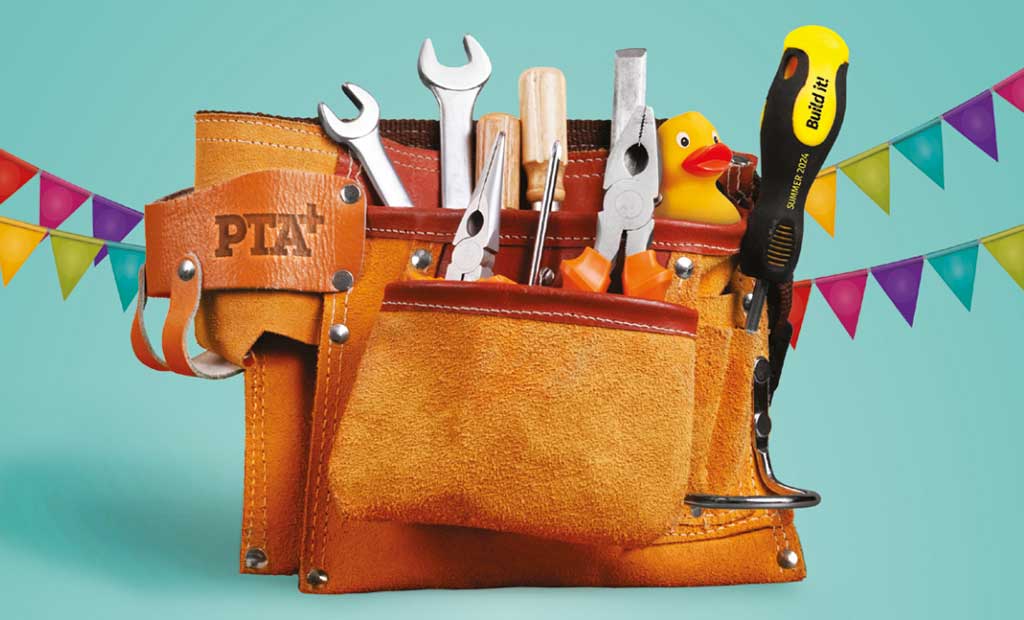I started making games to help my in-laws with their local Christmas tree festival. The trees were always beautifully decorated, but the kids wanted something they could touch, which often wasn’t allowed. So, I wanted to make something interactive that they could play with instead.
First, I built a buzz wire shaped like a Christmas tree. Whenever the loop touched the wire, the fairy lights went out. I also made a puzzle from metal bars that the children could assemble into the shape of a tree. After that, I built an interactive tree that resembled a character. Initially it ran an animated sequence where only its eyes and eyelids moved, but later I found an old touchscreen at work and adapted it so that the children could press buttons to make the tree smile and blink.
When my son started in Reception, I told the Friends I had these Christmas-themed games. They were thrilled, and that’s how my relationship with them began.
Seek inspiration
I’m always on the lookout for ideas and I often browse Facebook groups such as the PTA Ideas and Advice Network to see what other PTAs have made. One that caught my eye was a school with giant wind-up cows, which they raced on a track. But the cows are expensive, so I bought chicks for Easter instead and made the track myself.
When my son was a toddler, I built him a remote-controlled ride-on Land Rover using the electrics from a mobility scooter. Later, I made him a bigger Jeep. When he started school, I noticed the roadway markings in the Reception playground that the school uses for road safety lessons. I knew it would be perfect for the summer fair, where the children could drive laps. Inspired by the learner drivers’ course at Legoland, we award them their ‘driving licence’ when they complete a full circuit.
Get creative
Other ideas, such as the Turbo Toilet Teacher Terroriser 2000, have come from the school staff. Every year, the Friends would organise a game of Soak the Teacher using sponges and a set of stocks in the staff car park. Although they put a tarpaulin down, some sponges would fly off the end and by mid-afternoon, pupils were throwing cold, gravelly sponges at the staff. The headteacher suggested making a toilet the teachers could sit on that would flush clean water over their heads.
The time it takes to transform an idea into a finished game depends on its complexity. For example, I bought my wind-up Easter chicks online and tested them on my kitchen table to determine their speed and the distance they could cover: I worked out that they would complete a one metre long course in around two minutes. I also designed the track so that enough people would fit around it at one time.
- Take a look at our unusual fair games ideas
The Turbo Toilet Teacher Terroriser 2000 took much longer. First, I drew some sketches. I decided to use offcuts of wooden decking to build a frame at the bottom and remembered that my late father had a spare unused toilet in his garage. But I couldn’t think of how to make it flush. A mum at the school is a lecturer in engineering, but she and her colleagues couldn’t think of an easy solution. So, I called a design meeting in the pub with an engineer friend. We talked through different ideas, including using a hands-free flushing mechanism. I bought one, took it to pieces and experimented with it. Realising it was going to work was a breakthrough moment. The children would throw a bean bag at the sensor to flush the toilet and release the water. I knew then that the rest of the game would come together.
Another idea we achieved at a reasonable cost was The Floor is Lava. The Friends had funded a new playground frame, consisting of eight vertical posts with bars and cargo netting. We needed to either use it for a game or cordon it off for the summer fair, and I came up with an idea based on the TV show where participants navigate an obstacle course without touching the ground (because it’s lava). I bought a red tarpaulin online for £50 and cut it to fit under the playframe. Then I used ropes and poles to mark the boundary and made obstacles from offcuts of decking, but you could also use PE benches, crates or blocks.
I recently came across an interesting idea for a duck racing game that would be a big build and lots of fun. It involves using boat bilge pumps to pump water from a tank into lengths of roof guttering set at a slight angle. The water flows down the slope, across the back and ultimately back into the tank. Players use a bath duck and pump as fast as they can to propel it around the course. You could have two players next to each other and hold a race!
Team effort
I always discuss my ideas with the PTA committee members and the headteacher, and we set some ground rules. For The Floor is Lava, we allowed ten children to use the apparatus at one time, and there was always an adult supervising the game, which is the same as at playtimes. Another volunteer took money and supervised the queue. If the children started acting silly, the helpers would blow a whistle and ask them to stop. These rules helped maintain a level of control and monitoring during the game. We noted the ground rules on the risk assessment, which the headteacher signs off.
- Plan a PTA summer fair
- Download our summer fair checklist to help you stay organised
We have also developed rules for our Jeep driving, especially for the younger children. The Jeeps are powered by a 12-volt battery with an old windscreen wiper motor in the back. They travel at walking pace and are speed limited. To ensure safety, there’s a kill cord at the back of each one that an adult helper can pull to stop the vehicle instantly. Volunteers supervising the driving wear high-visibility vests with ‘driving instructor’ written on the back so they can help the children with steering whenever necessary. We always keep the two vehicles apart and use a whistle to alert spectators who accidentally stray onto the track.
Give it a go
If your PTA doesn’t have a resident maker or you’re not ready for a large project, review your available resources and don’t underestimate your skills. You might make a game of Topple the Teacher by printing colourful pictures of the staff with silly faces, wrapping the images around tin cans, and stacking them on a table. If you’re up for a bigger challenge and have access to a handsaw and a cordless drill, try building my chick-racing track.
Another easy game to make is Pin the Tail on the Donkey. I made a Christmas version by sticking a poster of Rudolph on an A1 magnetic board and cutting out round nose shapes from flexible magnetic sheets.
Ask around
There are lots of ways to find someone with practical skills. Get some ideas together and approach your parent community with a specific request. Someone may be happy to give up a few evenings or weekends even if they don’t want to participate actively in anything else.
If that doesn’t work, look beyond the PTA. Try asking a community group such as Men in Sheds. Make it easy for people to say yes by developing a team mindset. If one person makes the item, someone else can paint it and a further volunteer can run the game on the day. It’s good practice to offer to pay for the materials.
Besides helping make your best-ever fair, developing a strong relationship with a practical helper can also lead to new opportunities. They may be willing to assist with projects such as constructing a mud kitchen or creating a reading nook for the library.
Richard Brigg is chair Moorside Friends in Lancaster (630 pupils)










